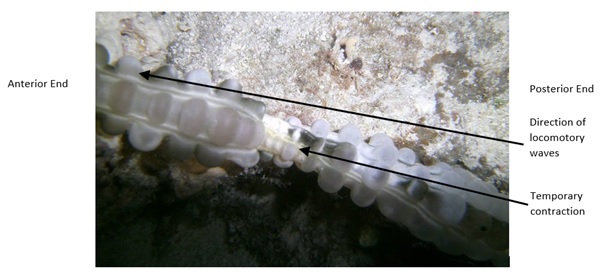Life History & Behaviour
Reproduction
To the author’s knowledge, the reproductive strategies of E. godeffroyi have yet to be described. However, typically of the class, holothurians primarily use a sexual reproductive strategy of individuals synchronously releasing sperm and eggs into the water column. These are known as spawning events and are usually triggered by changes in environmental factors.
Locomotion
Although the muscle movement of E. godeffroyi has yet to be described in the scientific literature, behavioural observation of the specimen collected from Heron Island supports the findings of the study conducted on E. lappa, E. godeffroyi’s most closely related species. The genus moves by peristalsis using unique locomotory waves that have not been described in any other organism.
Peristalsis in terms of holothurian locomotion is defined as ‘any muscular contraction moving along a radially flexible tube in such a way that each component wave of circular, longitudinal or oblique muscular contraction is preceded or followed by a period of relative relaxation of all similarly oriented muscle within a given tubular segment’ (Heffernan and Wainwright, 1974).
E. lappa moves by a direct peristaltic locomotory wave in which there is no elevation of the body cylinder’s major axis (Heffernan and Wainwright, 1974). Thus, the ‘wave’ moves anteriorly in the same direction to that of the animal (Heffernan and Wainwright, 1974).
This type of locomotion is unique in holothurians. It has been previously described in both Stichopus panimensis and Astichopus multifidus, which display similar peristaltic locomotory waves; however,these waves resulted in a localized temporary elevation of the body cylinder’s major axis (Heffernan and Wainwright, 1974).

Figure 1: Direction of locomotory waves along E. godeffroyi's body in the anterior direction
|